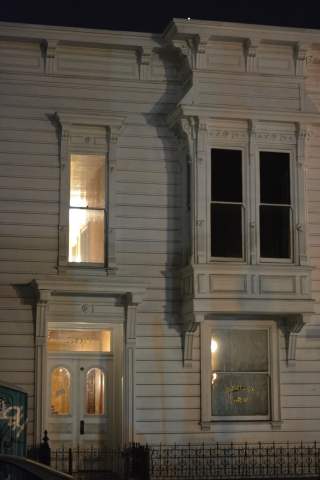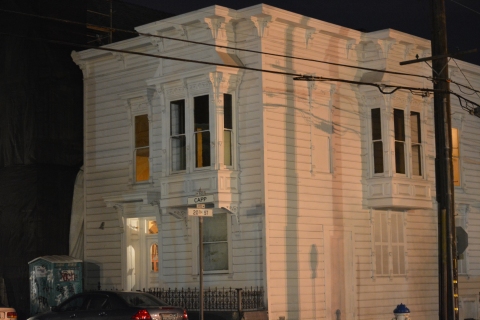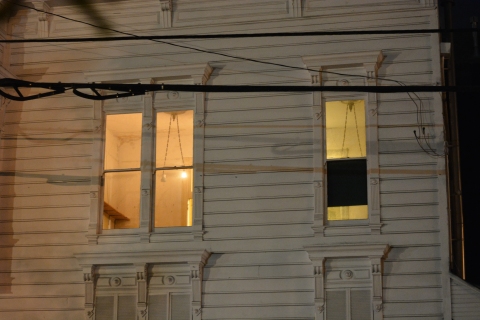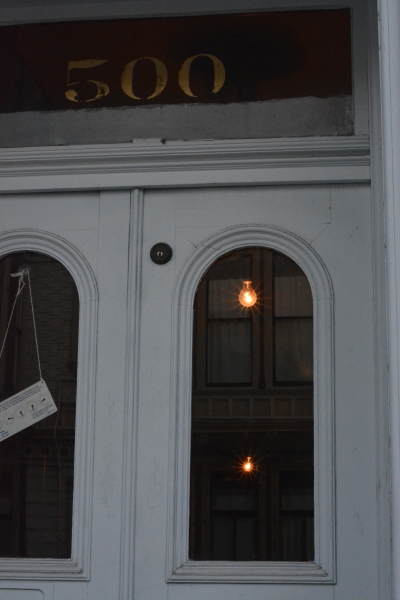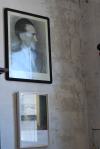Starting late November of last year, I’d often find myself walking through the Mission District in San Francisco shortly after sunrise. The walk itself was seven blocks, and due to a combination of the topography and my obsessive desire for the most efficient route, I passed by the house on the south-west corner of 20th and Capp street a minimum of twice a day.
500 Capp street. It’s a faded two-story old home, across from Alioto Park. The exterior is matte gray, the kind of gray that looks to be rescued from painting the exterior of a Navy ship, battleship gray, uniform. There is a waist-high iron fence with an unlocked gate around the front entrance on Capp street, and all the first-floor windows facing the park on 20th are shuttered.
I walk by this house for weeks.
The first thing I notice about it was the faded lettering on the front window facing Capp street. Accordion, spelled out in a barely legible arc of deteriorated gold leaf.
Weeks later, I walk by late at night. The orange light-bulb outside by the front door is on, burning brightly. A bare phosphors bulb in a simple utility setting. Was this always on at night? I hadn’t noticed, and resolve to pay attention when passing by in the future.
Weeks go by. it turns out that the exterior light was not on all the time. Sometimes, it’s off, even late at night. Sometimes other lights are on in the building. A sign of life within?
More days, weeks pass.
One day, I am walking back earlier than usual. As I pass by the house, I unlatch the front gate on impulse, walk up to the door, and peer in through the glass. Inside, there is a bare plaster wall visible to the right of the door, with post-it notes of various colors stuck to it. A hat stand made of horns. A staircase leading up, made of wood, to the left. The interior lighting is markedly different in intensity, hue, and shape from contemporary fixtures, or what would normally be expected in a similar space. Something seems odd about the whole set-up, and I cannot help but be even more intrigued. It does not seem like a perfectly preserved historic house, full of period detail and slavish to the historical record. Something is amiss, even though the house is certainly old enough to delight historical preservationists.
I knock. Silence.
I knock again.
Silence again.
Over months, other things are revealed.
Late afternoon, on the days surrounding the weekend, the dice game from Alioto park migrates to the shade of 500 Capp street. People gather at the corner, and throw dice toward the house while joking in Spanish.
There is a window on the second story, facing the park. Standing on twentieth street by the gates of Alioto Park and facing this window creates an interesting composition: looking into the house through this aperture shows some kind of table with a light made of horns, the horns protruding over the desk in a slinky manner, similar in form to live cats who peer out of other windows in other houses along Capp street on my runs through the Mission District. All eyes looking at me. Hunter, prey.
Also: a new piece of shiny galvanized metal pipe, improbably long, rising out of the back part of the lot. This seems to be a different structure than the house, a more recent add-on, or a old garage fallen into slight disrepair. There is a window, a triangle window beside two triangle dormers and it looks like this pipe intersects the window. All this intersecting geometry crystallizes into proof that old houses can have new pipes, which provides incalculable cheer.
From the roof of an adjacent structure, I gaze over at 500 Capp street and think: what’s on that roof? Some kind of structure. What has the owner done up on the roof, I wonder. Is it a lean-to? Rooftop greenhouse?
Who lives there. And what’s up with those post-it notes?
—
The answer is revealed unexpectedly.
Tom Marioni speaks off the top of his head at an event for the 50th year of Crown Point Press. He’s talking about David Ireland, his work on the back wall at the Museum of Conceptual Art, and maintenance art. That’s the beginning of his work on 500 Capp Street, he says.
This was the moment when I put together that artist I’d heard about in passing, David Ireland, with that house I’d been walking by for days, weeks, months: 500 Capp street.
That house.
That house with the cat sculpture at the desk overlooking the park, and the on-again, off-again lights, and the post-it notes by the door, the off-kilter vibe.
—
Eventually, the previous knocks are answered, and the front door of 500 Capp street swings open.
—
Inside the house.
A framed photo hangs on the wall in the entrance room, the oldest photo of the house. A photo of the house before the ravages of time: a beautiful tree in the backyard, the same elegant metal fence. The exterior of the house is slightly different: a door on the first floor 20th street side. Some windows. No adjacent outbuilding. Timeless elegance.
Light. Lights, lighting. Already noted as important on the outside, even more important on the inside. The light bulbs are phosphorous or silver mirrored. Most of the light fixtures upstairs seem to be original fixtures, but refinished, and double-hung, but hung with slightly different bulbs. Nothing matches, or perhaps the rare bulb matches. There is one circular fluorescent bulb, centred on the top of an exterior door on the second floor. There is a southern-facing skylight in a narrow, newly-created space adjacent to the stairwell on the second floor.
The windows often have the interior wood molding removed, showing a gap between the window frame and the rest of the plaster wall. The window shades go from the bottom of the window, to the top. The window treatments and support utilities are below, not above. Some of the shades are in a state of ruin, falling in irregular ways and with varying rope tension all the way to the floor. The reversed window treatments drive the Marin Headlands people bonkers, the curator says with a smile.
This is very typical, says the curator. He used to do this kind of stuff. He liked the light, wanted the light, and sometimes he wanted to walk around naked with some privacy, so window shade treatments that grew from the bottom, that echoed the pulleys and weights inside the window casing, were ideal.
I ask the curator: what is your favorite time to be in this space. Nighttime, she says.
Glass. He loved old glass, and so loved one century-old window pane that when it broke, he filled in the window pane with 5mm copper etching plates, and before he did so he recorded himself talking about the view, outside the window. There is a photo of the view, out the window. It’s completely different from what’s outside the window now, a church stood where Alioto Park is now, and as the participants look into the photo and our eyes go up Capp Street, we think we can see the back of the old movie theater, before catching sight of the 412 curved windows just before the photo’s vanishing point is reached.
Copper. Was important to David Ireland, for many factors. Used in printmaking. Used in electrical. Used in plumbing. Elemental, I say. Formed copper will last forever.
Cases and furniture filled with carefully-placed objects. Imprisoned inside furniture, there are cases with things inside of them, one on each floor. The things inside the cabinet upstairs include: a bottle of 100 year old water, from washing a 100 year old object. An implausibly large concrete sculpture, painted bright red, leaning nonchalantly against the back of the delicate antique cabinet. Next to it, smaller concrete in a natural color, some works on paper
Horn. Synthetic horn. A synthetic narwal horn. Luminescent, a beacon in the cabinet box. There are horns in the dining room downstairs, horns and a skull on the floor of the upstairs hallway, horns, horns, horns.
Concrete and wire.
There are concrete shapes all over the house. Some, affixed to the ceiling by the entryway. I call these satellites, and ask about them. They say: everybody asks about this.
Bag-cast concrete. Hand-molded concrete. Concrete on floors, in corners, with mirrors. Concrete used with electricity and lighting to make hybrid light/concrete/electrical sculpture. Clearly, if one considers electricity some generation’s new media, David Ireland was working in that generation’s new media. It’s as if he was working with electrical utilities in an alternate universe, with wires poking out of walls, with unfinished electrical outlets, ganged holes with some electrical, leftover holes int he floor from running electrical utilities. All the lights on the downstairs table have cast concrete bases, light switches explicitly noted with boxed terminals in the composition, simple no-fuss utility of construction, material, design.
Plaster. The walls have the same general idea as evidenced in later iterations of the same concept, ie Marin Headlands Rodeo room. Clearly, this resonates with Abigail and I since we’ve just spent months hand-chiseling paint off coved plaster ceilings, carefully stripping off wallpaper from ancient lime-coated plaster and adoring the faded yellows of aged plaster.
Type. Words. There are books. Scraps of paper affixed to the wall. Plaques installed in specific locations to commemorate the removal of a heavy safe, and the scrapes during the removal. And so on, for the removal of heavy industrial punch on the ground floor. Most of the hung art, if one looks closely, has type or letter forms. Some of the horn sculptures downstairs has a type component. Duchamp upstairs, Marioni downstairs. Downstairs, in the dining room, in a room of really incredible things, what do I look at? The Marioni beer bottle, and his MOCA print. Charming.
Time. He bought this in 1976, and worked for years and years to scrape down the walls, create the light and space desired. Year after year of perfecting a particular space, of refining rooms and spaces or destroying older, composed spaces and creating new spaces. What rooms are older? What’s newer? From personal experience, the bathrooms and kitchen areas are most malleable.
Archive. The accordion player who lived in the house before David Ireland bought it had a work room on the first floor, eventually filled with his horded items that were only gradually emptied out when David Ireland took possession. That room is currently not on the tour, doors remaining firmly shut for the duration. Inside is a room, filled with the horded personal items of David Ireland. The snake eats its tail. The impending seismic work, which was the determining factor for this tour: it is most probable that at least one wall, carefully refined to the most elemental and covered in an epoxied sheath, will crack or become ill-formed during the structural work. Will the walls be repaired? Or repaired to respect the crack? Will the small sign posted by this crack say, with appropriately small type: the structure has been secured. What of fire? A perpetual danger for a wooden house: at least two fires have been narrowly averted, in 1906 and 2007. The roof structure remains a mystery, as does the excavated forms in the basement. This house seems to be always the outside, the viewer ever looking in.
—
There is some discussion, abbreviated and summarized here:
1) The high-gloss floors. Shiny floors. The photo of two wicker chairs, set on shiny shiny floors in front of the windows, shades down. The chairs were commissioned by David Ireland, and placed in front of the broom sculpture. This is the image used on the invite for the first NY art show featuring 500 Capp street. The floors are less reflective now, but will be restored to the original high-gloss finish.
2) Permitting. There’s something fascinating about the various rounds of historical surveys assessing 500 Capp street, and the story that this tells in the context of SF and the Historic Preservation and City Beautiful movements of the 1970s. Adaptive re-use? Adaptation? Something borrowed, something new. I told one of the curators that I read the SFDBI permit for the seismic work, which was interesting and indicated the rebuilding of the outbuilding for an on-site curator or artist program. Clearly, the fire-damaged house next door is a better and more attractive choice for this. She indicated that the SFDBI inspectors or planning people picked her permit at their favorite of 2011, and had their annual party there. Hats off, I said. There’s some common rescue impulse between the initial purchase by David Ireland in the 1970s and the transfer to conservatorship in the 2000s. Pan pan, echoed across time. We discussed the 1976/1990 historical survey paperwork, and she indicated that there is a more recent one, that takes better note of the inherent architectural features of the house.
3) Fire. The recent fire of the adjacent buildings, the fire jump 500 Capp street but hit the two buildings to either side. One of which is damaged and now has squatters. Squatters living in the burned out shell next door sadly increase the probability of additional fire in the future. If then, what?
4) African travel, hunting, horn and trophy collecting. There is more African influence here than expected, from his travel and work.
5) Re-patriation of David Ireland work that has a strong context or relationship to 500 Capp street. They have one chair. Need another, perhaps can get it by acquisition or loan from SFMOMA? SFMOMA apparently has the broom sculpture.
Seen
500 Capp Street Foundation
Chinati Foundation
Judd Foundation 101 Spring Street
di Rosa
La Casa Azul
Future
The White House
